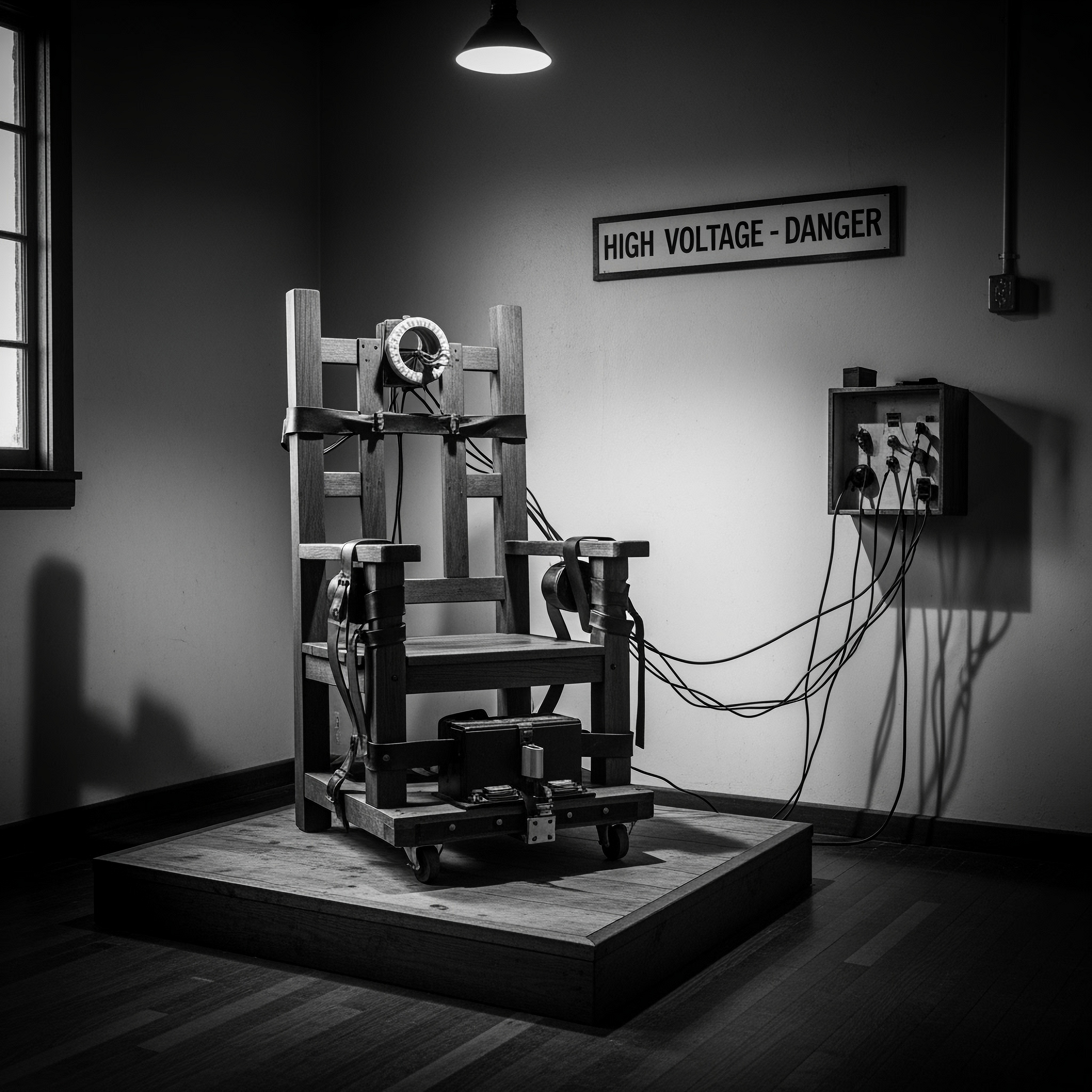The story of Martha M. Place is a tragic and dark episode in American criminal history, culminating in her final years of insanity that made her the first woman to be executed in the electric chair. Her actions and shocking end remain a lesson to this day about how mental instability can lead to devastating consequences. Martha M. Place was born Martha “Mattie” Garretson on September 18, 1849, in Readington, New Jersey. At the age of 23, she suffered a serious accident when she was struck on the head by a horse-drawn sleigh. Her brother later claimed that she never fully recovered from this incident and that it caused her to become mentally unstable. Whether this accident actually laid the foundation for her later actions remains a mystery, but many believe that this was the beginning of her tragic turn of events. Martha, who had previously earned her living as a seamstress, married a man named Wesley Savacool after her accident, with whom she had a son, Ross. But when Ross was 3 years old, Martha’s husband ran off and died shortly afterwards, forcing Martha to give her son up for adoption. Martha then moved to New York, where she took a job as a housekeeper for the widower William Place in Brooklyn. In 1893, Martha married the widower William Place, who already had a 17-year-old daughter named Ida from his previous marriage. It is believed that the marriage was primarily arranged so that William could get help raising his daughter Ida. However, rumors soon began to circulate that Martha was jealous of the affection William showed his daughter. William had to call the police at least once to have Martha arrested for threatening Ida. On the morning of February 7, 1898, a fateful argument broke out between Martha and William. As so often, Ida defended her father, who finally left the house to go to work. Enraged by Ida’s behavior, Martha ran to William’s desk, where he had stored acid that he needed for his hobby of photography. Martha poured the acid into Ida’s face. She then suffocated Ida with a pillow. When Ida’s father returned home from work that evening, Martha attacked him with an axe. Seriously injured, he dragged himself out of the house and called for help in the street. When the police arrived at the house, they found Martha lying unconscious on the floor, with clothes over her head and gas from the stove burners flowing into the room. Martha had tried to take her own life, but her suicide attempt had failed. But the real cruelty awaited upstairs in the house. There, the police discovered the body of Ida Place. Her face was horribly disfigured by acid, and she had died of suffocation. The sight was so shocking that even experienced investigators fell silent. While Martha insisted on her innocence despite overwhelming evidence, the contemporary media found it difficult to muster any sympathy for her. One newspaper report described her as “tall and thin, with a pale, sharp face” reminiscent of a rat. This impression, coupled with the gruesome details of her crime, contributed to her being virtually demonized in the public eye and given the name “Brooklyn Murderess.” Martha Place was eventually found guilty of murdering her stepdaughter Ida in 1899 and sentenced to death. Her husband was the main witness for the prosecution. A plea for clemency to the governor of New York State, Theodore Roosevelt, was rejected. Since the New York authorities had never executed a woman in the electric chair before, they had to develop a new method of attaching the electrodes. They decided to cut her long skirt and attach the electrode to her ankle. Martha’s thick, gray hair was also cut back so that the electrodes could be placed on her forehead. Edwin F. Davis was the executioner who carried out the death sentence on March 20, 1899, at Sing Sing Prison in Ossining in the presence of 18 witnesses. Martha’s last words were, “God help me!” before 1,760 volts of electricity passed through her body. Her execution marked a grim milestone in the history of capital punishment. Her body was buried in the family cemetery in East Millstone. While Martha Place was the first woman to die in the electric chair, she was not the first woman to be sentenced to it. That dubious honor belonged to Maria Barbella, who was later acquitted and released from prison. Nevertheless, the story of Martha Place remains a gruesome reminder of the cruelty and profound consequences of mental instability. The events surrounding Martha Place captivated the public and generated sensational media coverage. A magazine article from that time describes in detail the police’s futile attempts to extract a confession from Martha. Finally, she was confronted with her dead victim, which forced her to confess to part of her actions. Martha had repeatedly emphasized that she was not a murderer, but had merely poured acid on Ida’s face. However, the evidence told a different story. The horrific wounds and the brutal manner in which Ida had been suffocated clearly showed that Martha was the one who had violently ended the young woman’s life. All these details were taken into account in court, and in the end there was no doubt about her guilt. After her conviction and during her time on death row, Martha Place had numerous hysterical outbursts. But through frequent prayers with her priest, she finally found a little peace. On the day of her execution, she was calm and composed, holding a Bible in her hands and accepting her fate. Witnesses reported that the execution was successful and without complications. The media reported sensationally on the execution, with some reporters even describing in detail the clothes and behavior of those present. The cruel act and the subsequent punishment remain a powerful example of the most extreme manifestations of human emotion and the consequences of mental illness. Her name remains etched in history as the first woman to die in the electric chair in the United States. Her story serves as a warning, reminding society that mental instability and unbridled emotions can lead to the worst forms of violence.
By Isabella Mueller
Welcome to my journey through creativity and discovery! My name is Isabella Mueller, and I invite you to explore the fascinating creative universes I create through my blogs. Since 2020, I have been dedicating my passion to telling captivating stories that are mysterious, historical, and emotional. My goal is not only to entertain, but also to inspire reflection and awaken the spirit of discovery in each of us. At isabellas.blog, the suspense of crime stories is combined with exciting travel tips. Imagine wandering through the picturesque streets of a new city, uncovering dark secrets hidden in the shadows of its history. Every piece on my blog is designed to make the heart of every crime fiction fan beat faster while sparking curiosity about unknown places. Here, you are invited to experience the thrill of the unknown and the beauty of our world—a perfect combination for all adventure seekers! My second blog, akteq.com, is all about true, unsolved crime stories. Under the motto “akteQ: Cold Case Stories,” I reveal the eerie and often tragic stories behind unsolved cases. Together, we can explore the mysteries of the past and delve deep into the human psyche. What really happened? Who were the people behind these mysterious events? In this blog, I invite you to ask questions and find the answers that often remain hidden in the dark. You can find another exciting chapter in my blogging career at thecastles.org. Here, I embark on an enchanting journey through the history of castles and palaces. Pause for a moment as you discover the stories hidden within the walls of these ancient structures. “Explore the enchantment, discover the history – your journey begins at thecastles.org!” These words are more than just a slogan; they are an invitation to anyone who wants to combine history and magic. Be inspired by the impressive stories and the fascination of bygone eras! But that's not all! At kripo.org, you'll find a comprehensive online magazine for real criminal cases. Immerse yourself in the world of crime, learn about the real stories behind the headlines and the people who are involved in solving them. With criminal.energy, I take you on a journey through the gripping stories of true crimes in which villains are hunted, caught, and convicted. The search for justice and the confrontation with the unknown are at the center of it all. TrueCrime Blog 187.news takes you into the depths of crime. And for those who want to travel the world, wanderlust.plus offers the opportunity to explore the world, one adventure at a time. It's all about the love of exploration and the joy of discovering new cultures and landscapes. Finally, truecrime.ch invites you to discover the dark side of Switzerland and Europe: true crimes, true stories. Let's discover together the stories that shape the world around us. I look forward to accompanying you on this exciting journey and hope you will share many unforgettable moments with me!

